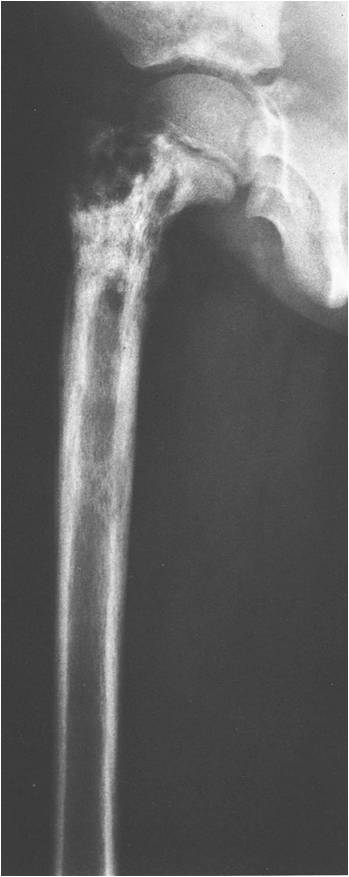Pathological Fractures
A pathologic fracture is one that occurs when the normal integrity and strength of bone have been
compromised by invasive disease or destructive processes.
■ Causes include neoplasm (primary tumor or metastatic disease), necrosis, metabolic disease,
disuse, infection, osteoporosis, alteration of normal bone repair mechanisms or iatrogenic causes
(e.g., surgical defect).
■ Fractures more common in benign tumors (vs. malignant tumors).
■ Most are asymptomatic before fracture.
■ Antecedent nocturnal symptoms are rare.
■ Most common in children:
■ Humerus
■ Femur
■ Unicameral bone cyst, nonossifying fibroma, fibrous dysplasia, and eosinophilic granuloma
are common predisposing conditions.
■ Primary malignant tumors
■ These are relatively rare.
■ Osteosarcoma, Ewing sarcoma, chondrosarcoma, malignant fibrous histiocytoma, and
fibrosarcoma are examples.
■ They may occur later in patients with radiation-induced osteonecrosis (Ewing sarcoma,
lymphoma).
■ Suspect a primary tumor in younger patients with aggressive-appearing lesions:
■ Poorly defined margins (wide zone of transition)
■ Matrix production
■ Periosteal reaction (Codman triangle)
■ Large soft tissue component
■ Patients usually have antecedent pain before fracture, especially night pain.
■ Pathologic fracture complicates but does not mitigate against limb salvage.
■ Local recurrence is higher.
■ Patients with fractures and underlying suspicious lesions or history should be referred for
evaluation and possibly biopsy.
■ Always obtain a biopsy of a solitary destructive bone lesion, even in patients with a history of
primary carcinoma, before proceeding with definitive fixation.